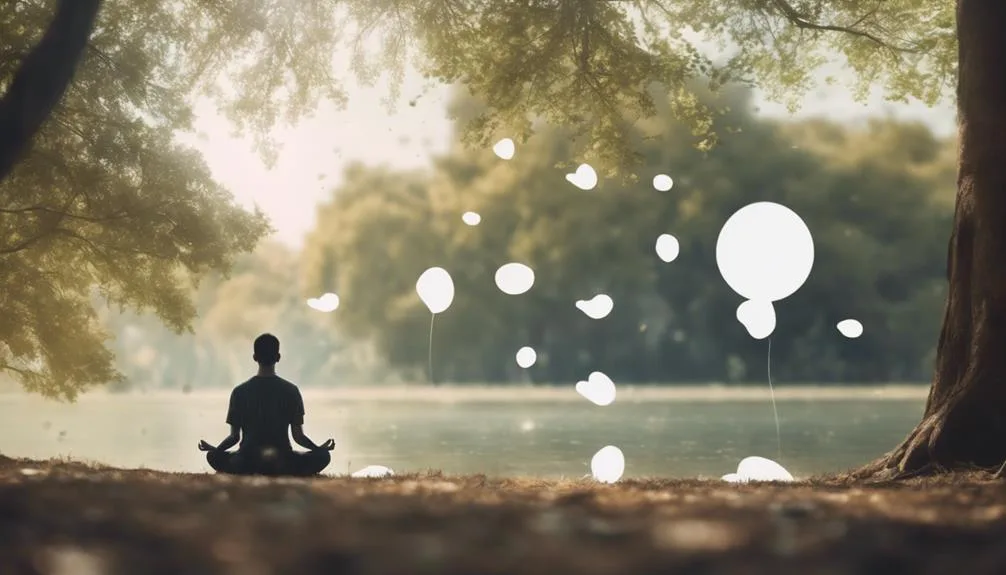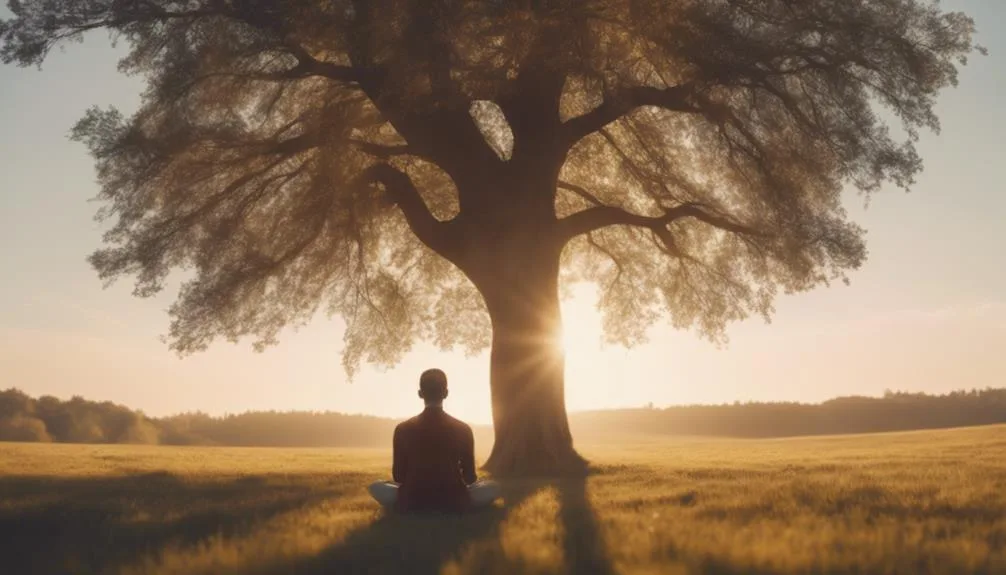Is Daydreaming a Form of Meditation?
Like a tree bending in the wind, your mind sways between the structured focus of meditation and the free-flowing nature of daydreaming.
You've likely found yourself lost in thought, wandering through a tapestry of memories and fantasies, only to wonder if this mental meandering could be akin to a form of meditation.
While both practices can usher in tranquility and a sense of detachment from the hustle of daily life, drawing a line between them isn't as straightforward as you might think.
As you ponder the nuances that define and differentiate these mental states, consider how blending them could unlock new doors to creativity and well-being, inviting you to explore further.
Key Takeaways
- Daydreaming and meditation engage the mind differently, serving distinct cognitive and emotional needs.
- While meditation focuses on present awareness, daydreaming allows for free mental exploration.
- Both practices can contribute to mental health, albeit through varied pathways of cognitive engagement and relaxation.
- Integrating meditative awareness into daydreaming can transform it into a purposeful, stress-managing practice.
Understanding Daydreaming
Daydreaming, a mental activity where your mind freely wanders into realms of fantasy, memory, or imagination, offers a contrast to meditation by lacking its focused present awareness. This spontaneous exploration allows your mind to drift without the constraints of objective or disciplined thought. Unlike meditation, which requires deliberate mindfulness or concentration, daydreaming doesn't demand a structured approach or a specific focus on the present moment. It's a process that lets your consciousness roam, fostering an environment where creativity and inspiration can flourish.
This mental escapism isn't just about being lost in thought; it's an integral part of cognitive processing that can lead to problem-solving and innovation. By allowing your mind to meander, you tap into a wellspring of ideas and possibilities that structured thinking often confines. While meditation seeks to ground you in the now, daydreaming enables a liberating departure from the immediate, inviting your mind to explore the boundless potential of your imagination and memory. This distinction is crucial for understanding the unique benefits and purposes each serves in mental wellness and creative processes.
Meditation Essentials
While daydreaming offers a freeform mental exploration, meditation provides a structured approach to achieving mindfulness and inner tranquility. Understanding the essentials of meditation is crucial to appreciating the difference between daydreaming and this practice focused on the present moment.
Meditation involves a range of techniques designed to train your mind to focus and redirect thoughts, enhancing your awareness of the present moment. Here are three key components of meditation that underscore its benefits:
- Breath Awareness: This technique involves concentrating on your breathing, which helps in reducing stress and improving concentration. By focusing on each inhalation and exhalation, you anchor yourself in the present moment, distancing from wandering thoughts.
- Body Scan: This practice encourages you to pay attention to different parts of your body, noticing any discomfort, tension, or sensations. It's a form of mindfulness that promotes a deep state of relaxation and well-being.
- Loving-Kindness Meditation: This method focuses on developing feelings of goodwill, kindness, and warmth towards others, starting with oneself. It can enhance emotional regulation and foster a sense of connection.
Regular meditation practice not only cultivates inner peace but also significantly benefits mental health, improving emotional regulation, cognitive function, and self-awareness.
Comparing Processes

You've learned that daydreaming and meditation serve different purposes and involve distinct cognitive processes.
Now, let's compare their focus, how they engage the mind, and their effects on relaxation.
Understanding these differences will clarify why each practice holds unique benefits for mental health and well-being.
Daydreaming Vs. Meditation Focus
Understanding the differences between daydreaming and meditation is crucial as they engage the mind in contrasting manners. When you daydream, you allow the mind to wander freely into fantasies or past memories. This process is unguided and spontaneous. In contrast, meditation demands a disciplined approach:
- Focus: Meditation requires maintaining focused awareness on the present moment or a chosen anchor, unlike daydreaming where the mind leads without intentional direction.
- Control: You're encouraged to dismiss tangent thoughts during meditation and return to your chosen focus.
- Purpose: Clear focus and centered awareness differentiate meditation from the wandering nature of daydreaming.
Recognizing these distinctions helps in understanding how each practice impacts your mental state and wellbeing.
Cognitive Engagement Variations
Exploring the cognitive engagement in daydreaming and meditation reveals significant variations in how each process captivates the mind. While daydreaming allows your thoughts to wander into imaginative realms, promoting creative thinking, meditation demands a disciplined focus on the present, dismissing distractions for mindfulness and inner peace.
| Daydreaming | Meditation |
|---|---|
| Wandering thoughts & fantasies | Focused awareness |
| Encourages creative exploration | Aims for present moment awareness |
| Leads thoughts in various directions | Involves dismissing distractions |
| Purpose: Creative thinking | Purpose: Mindfulness & inner peace |
This comparison illustrates that while both daydreaming and meditation engage the mind, they do so in fundamentally different ways, serving distinct purposes. Understanding these nuances can enrich your approach to cognitive well-being.
Relaxation Effects Compared
When comparing the relaxation effects of daydreaming and meditation, it's clear that each employs a unique process of mental engagement to achieve calmness. Here's how they differ:
- Daydreaming allows your mind to wander freely into fantasies or memories, fostering relaxation through imaginative exploration. This can lead to a sense of calmness by escaping into creative thoughts.
- Meditation involves a focused awareness on the present moment, aiming for relaxation through mindfulness and concentration. This method cultivates relaxation by grounding you in the present.
- While both offer relaxation effects, their distinct approaches cater to varying preferences for mental unwinding. Some may find the imaginative escapism of daydreaming more relaxing, while others may prefer the grounding effect of meditation.
Mindfulness in Wandering

In the realm of daydreaming, mindfulness entails a conscious awareness of one's thoughts and emotions as they drift, without casting judgment upon them. This practice encourages you to observe the flow of thoughts that occur during daydreaming without getting entangled in them. By allowing the mind to wander freely, yet maintaining an observer's perspective, you're not only acknowledging the present imaginative journey but also staying grounded in reality.
Practicing mindfulness in this context involves recognizing when your thoughts have strayed and gently guiding your focus back to the present moment. This doesn't mean stifling your creativity or cutting short the daydream. Rather, it's about permitting the mind to explore, while simultaneously cultivating an awareness of this exploration. This balance ensures that you don't lose touch with your surroundings even as you allow your mind to explore various avenues of thought and emotion.
Creative Insights
Building on the mindful awareness of daydreaming, it's crucial to recognize how these mental wanderings can unlock creative insights. When we allow our mind to drift into daydreams, we're not just passing time; we're embarking on a journey that can bring us unforeseen ideas and innovative solutions.
Here are three ways in which this process unfolds:
- Exploration of Imaginative Worlds: Daydreaming allows for the exploration of scenarios beyond our immediate reality. This mental freedom is a fertile ground for fostering creative insights, as it lets our imagination roam free, unbound by the constraints of our current tasks or problems.
- Fishing for Inspiration: The act of daydreaming can be likened to casting a net into the ocean of our subconscious. Often, it's in these relaxed states that our mind captures fleeting moments of brilliance, bringing us the spark of an idea that feels both surprising and familiar.
- Growth of Creative Concepts: Allowing the mind to wander serves as a catalyst for the development of creative ideas. It's in the quiet moments of daydreaming that our brain can connect disparate concepts, leading to the growth and shaping of innovative solutions that can truly bring us forward.
Reflecting on Practice

Reflecting on your daydreaming practice can significantly enhance your understanding of the creative insights and mental rejuvenation achieved during these moments. By paying attention to the imagined scenarios and the emotions they evoke, you're not only indulging in a brief escape but also tapping into a wellspring of relaxation and mental refreshment. This introspection allows you to recognize the value of these spontaneous mental breaks and their contribution to your overall well-being.
Integrating meditative awareness into your daydreaming can transform it from a mere distraction to a purposeful practice. Meditation vs. daydreaming isn't a competition but a complementary process where one can inform and enrich the other. By applying mindfulness to daydreaming, you deepen the experience, making it more intentional and focused. This approach helps manage stress and enhances your mental health by cultivating a habit of present-moment awareness and acceptance.
Incorporating daydreaming into your daily routine, with a reflective and meditative mindset, not only boosts productivity and creativity but also promotes a balanced mental state. It's a testament to how nurturing your mind with gentle, imaginative wanderings can yield profound benefits for both your personal and professional life.
Frequently Asked Questions
Is Daydreaming a Form of Mindfulness?
You're exploring if daydreaming counts as mindfulness. While both involve the mind, mindfulness requires active, present-moment focus, contrasting daydreaming's free wander. They serve unique roles in mental health, making daydreaming distinct from mindfulness practices.
What Is Daydreaming a Form Of?
Daydreaming's a form of spontaneous mental wandering, allowing your mind to roam into fantasies or memories. It differs from meditation by lacking a directed focus, instead offering a creative escape and insight through unstructured thought.
What Are the 4 Types of Daydreaming?
You're off in la-la land, but there's more to it. The four types of daydreaming are positive constructive, guilty-dysphoric, poor attentional control, and obsessive-compulsive, each offering a window into your mental well-being and creativity.
How Do I Stop Daydreaming Meditation?
To stop daydreaming during meditation, practice mindfulness techniques, set specific goals, incorporate structured sessions, and allow designated daydreaming times. If it's affecting your life, seek professional help. This approach cultivates focus and reduces distractions.
Conclusion
In conclusion, while daydreaming and meditation serve different purposes, integrating mindfulness into daydreaming can elevate it to a meditative practice.
Imagine an artist, lost in daydreams, suddenly becoming aware of each thought's flow, using it as a canvas for creativity. This hybrid approach not only enhances mental well-being but also fosters a unique space for innovation.
Balancing these practices, therefore, isn't about choosing one over the other but about enriching the quality of both mental wanderings and present-moment awareness.






